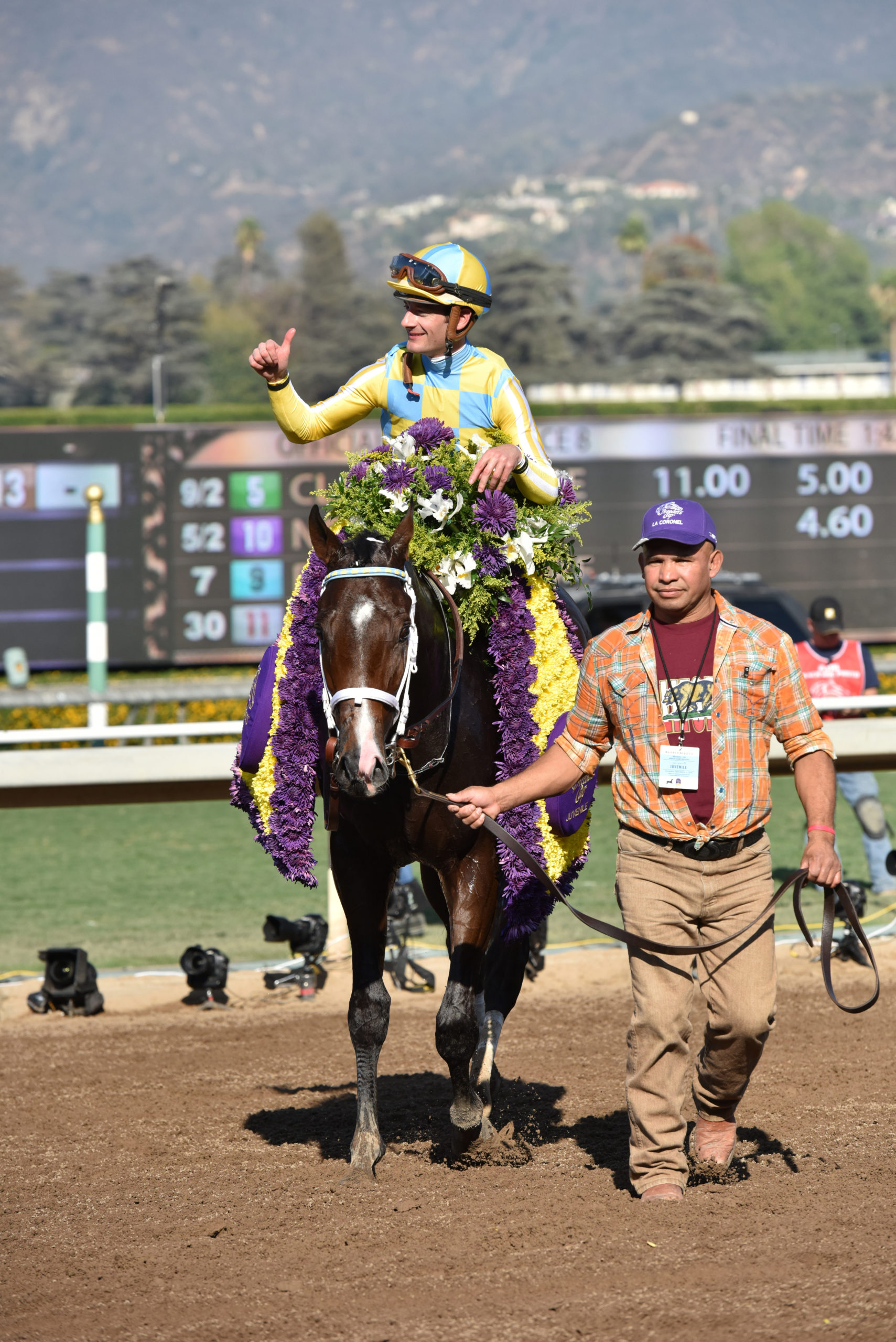
Santa Anita hopes to return to live racing March 29
By Terry Miller
The Los Angeles County District Attorney confirmed on March 15 that it has assigned investigators to work with the California Horse Racing Board with an eye on investigating the unusually high number of equine deaths at the race track in the past couple of months.
In a concise email statement Monday morning, public information officer for the district attorney, Venusse D. Navid wrote: “At this time, the District Attorney’s office has assigned investigators to work with the California Horse Racing Board.” No other details were provided to this newspaper.
This investigation follows a call for a congressional committee to investigate treatment of racehorses at Santa Anita Park following the deaths. Congresswoman Judy Chu wants the House Energy and Commerce Committee to investigate the treatment of horses, not only at Santa Anita but at racetracks across the country. Last Friday morning, Chu expressed her shock at the 22 deaths at Santa Anita recently:
“I am outraged by the deaths at Santa Anita racetrack. Animals deserve to be treated with dignity and compassion, and the use of race-day medication like Lasix must stop. The U.S. is an outlier when it comes to the practice of injecting horses with this drug on race-day and we need answers on the impact of this practice at Santa Anita and throughout the country. I am calling on the House Energy and Commerce Committee to investigate and hold a hearing on the treatment of horses at Santa Anita and throughout our country, and to examine legislation like the Horseracing Integrity Act that would improve safety for racehorses. I will work with my colleagues to ensure that all animals are treated humanely and to get to the bottom of this crisis. Until we know the horses are safe, the Santa Anita Racetrack should be closed.”
In addition to the City of Arcadia losing money while the track is closed, the other victims, aside from the horses, are those who work directly with the thoroughbreds such as jockeys and almost everyone working directly or indirectly with the equines.
Since early March many have simply not received paychecks and the end result is that some jockeys have moved to different tracks just to make ends meet. Thus far, there has been little comment from the track regarding the employees at Santa Anita.
For additional economic impacts we turned to Arcadia City Manager Dominic Lazzaretto for his perspective. In a written statement via email Wednesday afternoon, Lazzaretto said:
“Unfortunately, I can’t give you an overall picture of the economic impact (restaurants, hotels, etc.) because we just have never done that kind of an overall analysis.
“What I can say is that the city loses an average of about $5,000 per lost racing date. Losing the ‘Big Cap’ a few weeks ago was a much larger impact because that is one of their biggest racing days of the year.
“Santa Anita has been a very good partner to the city over the years. We applaud their bold decision to update their practices to better protect the health of their athletes and we look forward to everyone enjoying this sport for generations to come.”
On March 16 Santa Anita Park, Golden Gate Fields and the Thoroughbred Owners of California (TOC) apparently reached an agreement to “protect the safety and welfare of horses and riders in the state. This collective mandate enacts the most stringent medication policy in North America.” Belinda Stronach, president and chairman of The Stronach Group (TSG), which owns both Santa Anita and Golden Gate, outlined these new regulations earlier this week in an open letter.
“This is a complete revision of the current medication policy for thoroughbred racing. We have worked through the implementation of this groundbreaking model with our stakeholders and the California Horse Racing Board,” said Belinda Stronach. “TSG is committed to the principles of safe horse racing for both equine and human athletes
and to making California racing the best in the world. It is my hope the other tracks in California will follow suit. TSG will begin consultation with our stakeholders in other states to put these standards into effect in those jurisdictions, in the best interest of horse racing.”
“I very much appreciate the efforts made by The Stronach Group, the TOC, and the CTT in coming to this agreement, to improve and enhance horse and rider safety,” said Chuck Winner, California Horse Racing Board (CHRB) chairman. “The CHRB will continue to work with the stakeholders as they move forward. I plan to move the previously scheduled March 21st board meeting to March 28th in order for the full board to consider and take action on those items on which CHRB approval is required. March 28th allows for the legally required 10-day public notice.” Santa Anita, Golden Gate and the TOC have agreed to the following initiatives for racing
and training:
- Complete transparency of all veterinary records.
- Strict limitations on the use of any pain or anti-inflammatory medication and
treatment, including legal therapeutic NSAIDS (nonsteroidal anti-inflammatory drug), joint injections, shockwave therapy, and anabolic steroids. - Trainers must apply for permission to work a horse (a timed, high-speed training exercise) at least 48 hours in advance.
- No therapeutic medications of treatments will be allowed without a qualified veterinary diagnosis from a state licensed veterinarian.
- Significant and strict Out-of-Competition Testing (OCT).
- Increasing the time required for horses to be on-site prior to a race.
- A substantial investment by The Stronach Group in diagnostic equipment to aid in the early detection of pre-existing conditions.
- Santa Anita, Golden Gate and the TOC are also in alliance to change the use of the cushion crop. This evolution of a centuries-old practice will only allow the use of the crop as a corrective safety measure. This new directive has already gone into effect during training hours.

Regarding the growing concern about use of the riding crop, which is more commonly called a whip, jockeys use to try and make their hose run faster, the open letter stated: “Experts who have studied this controversial issue point out that Victor Espinoza’s ride on American Pharoah in the Kentucky Derby, used his whip 32 times.”
Tim Ritvo, COO, said, “The time has come for this industry to evolve. It must do so for the sake of the horses and the people who depend on this sport for their livelihoods. Moving to international standards will help to set the right foundation for racing and fairness. We love the sport of horse racing and want it to succeed today, tomorrow and long into the future.”
CHRB will address all these changes March 28. This agreement will effectively phase out all race-day medication at Santa Anita and Golden Gate under rules consistent with, or more restrictive than, the International
Federation of Horseracing Authorities (IFHA) standards. The IFHA regulations are in effect at premiere racetracks throughout the world and are the benchmark for equine safety and welfare.
All horses born in or after 2018 will race at Santa Anita and Golden Gate with no race- day medication, including the diuretic furosemide, commonly known as Lasix. This means all 2-year-old horses starting in 2020 and after will be racing medication free. All horses born prior to 2018 will race at Santa Anita and Golden Gate with the same
guidelines, however, following the recommendation of veterinary experts for the best interest of the health of the current horse population, Lasix will still be permitted but at a maximum of 50 percent of the current levels.
“Lasix is an efficacious medication for the treatment of exercised-induced pulmonary hemorrhage (EIPH) and has been legal in California for almost a generation of trainers,” said Dionne Benson, DVM, executive director and COO of the Racing Medication & Testing Consortium (RMTC). “This change will require many trainers to manage their
horses without the aid of this medication in racing for the first time ever. In order to ensure this is done properly and thoughtfully, we need to allow time for this adjustment.”
These modernizations are in addition to the previously announced commitment to the continued engagement of outside experts to regularly review Santa Anita’s dirt, turf and synthetic courses to ensure the safest racing surfaces in the world.
Meanwhile, some in the industry worry about the long term future of horse racing in general and, with the Breeders’ Cup slated for Santa Anita just seven months away, people are pondering if this may be cancelled altogether.
Jim Gluckson, Breeders’ Cup Ltd., sent a statement out Thursday but made no immediate comment with regard to the prestigious 2-day event slated for Santa Anita in November:
“Like all of racing we are profoundly saddened by the loss of a life at any racetrack and we are heartbroken for those whose livelihoods are dedicated to the care of our horses. As an organization, the Breeders’ Cup stands for the highest levels of safety and integrity. We support the effort by The Stronach Group to propose important changes and we commit to working with the racing industry in California and elsewhere to achieve meaningful reform on a national basis.
“We recognize that for real change to result from this difficult situation we must engage those stakeholders quickly and dedicate time and other resources. We must, as an industry, press forward on implementing existing best practices and rapidly proceed with the consideration of further reforms such as those proposed by The Stronach Group in California. It is vital that we all do so.”
Once this agreement is approved by the CHRB, Santa Anita and Golden Gate will race with these enhanced new safety and welfare protocols in place. Because state regulations require a 10-day approval process, Santa Anita is planning to return to racing on March 29.







